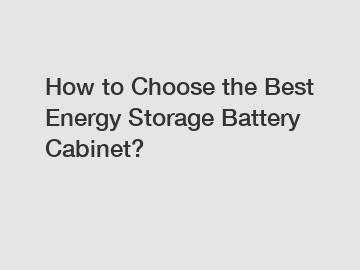How to Choose the Best Energy Storage Battery Cabinet?
Apr. 06, 2024
Energy storage battery cabinets are an essential component of any renewable energy system. They store the energy generated by solar panels or wind turbines for use when the sun isn't shining or the wind isn't blowing. Choosing the right energy storage battery cabinet is crucial to ensure the longevity and efficiency of your renewable energy system. In this article, we will discuss how to choose the best energy storage battery cabinet for your needs.
**Capacity and Power Requirements**.
When choosing an energy storage battery cabinet, it is essential to consider your capacity and power requirements. The capacity of a battery cabinet is measured in kilowatt-hours (kWh) and determines how much energy it can store. The power rating, on the other hand, is measured in kilowatts (kW) and determines how much power the battery can deliver at any given time. .

It is crucial to calculate your energy usage and determine the size of the battery cabinet you need based on your capacity and power requirements. You should also consider future growth in energy usage when choosing the capacity of your battery cabinet.
**Battery Chemistry**.
Another crucial factor to consider when choosing an energy storage battery cabinet is the battery chemistry. Different types of batteries have different characteristics, including cycle life, depth of discharge, and temperature sensitivity. Some common battery chemistries used in energy storage systems include lithium-ion, lead-acid, and flow batteries.
Lithium-ion batteries are widely used in energy storage systems due to their high energy density, long cycle life, and fast charging capabilities. Lead-acid batteries are a more cost-effective option but have a shorter cycle life and lower energy density. Flow batteries are another option that offers long cycle life and scalability but may have higher upfront costs.
**Safety and Reliability**.
Safety and reliability are of utmost importance when choosing an energy storage battery cabinet. Look for batteries that have built-in safety features such as thermal management systems, overcharge protection, and short circuit protection. It is also essential to choose batteries from reputable manufacturers with a proven track record of reliability.
Ensure that the battery cabinet is certified by relevant authorities and meets industry standards for safety and performance. Regular maintenance and monitoring of the battery system are also essential to ensure its safe and reliable operation.
**Cost and Return on Investment**.
Cost is another critical factor to consider when choosing an energy storage battery cabinet. Compare the upfront costs of different battery options, including installation and maintenance costs. Calculate the return on investment (ROI) for each option based on factors such as energy savings, system longevity, and potential incentives or rebates.
Consider the total cost of ownership over the lifetime of the battery cabinet, including maintenance, replacement, and disposal costs. Remember that investing in a higher-quality battery system may result in long-term savings and better performance.
In conclusion, choosing the best energy storage battery cabinet requires careful consideration of capacity and power requirements, battery chemistry, safety and reliability, and cost and return on investment. By taking these factors into account and consulting with renewable energy experts, you can select the battery cabinet that best fits your needs and ensures the efficient operation of your renewable energy system.
For more information on energy storage battery cabinets, feel free to contact us.
For more information, please visit diy kit battery assemble solution, c&i system, 51.2v 280ah pack diy battery box kit.
324
0
0


Comments
All Comments (0)